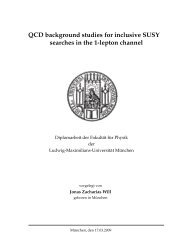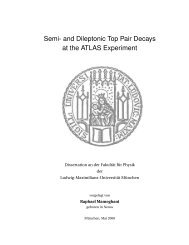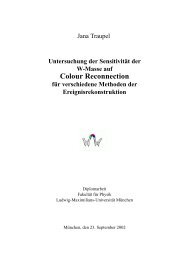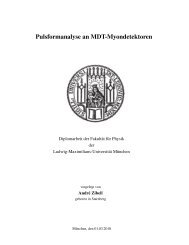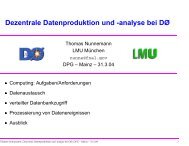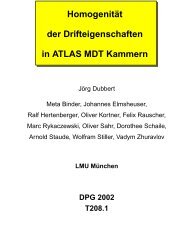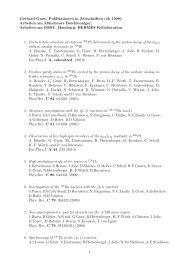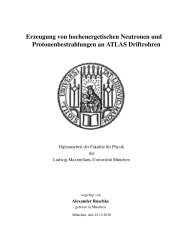development of micro-pattern gaseous detectors – gem - LMU
development of micro-pattern gaseous detectors – gem - LMU
development of micro-pattern gaseous detectors – gem - LMU
You also want an ePaper? Increase the reach of your titles
YUMPU automatically turns print PDFs into web optimized ePapers that Google loves.
18 Chapter 1 Interactions <strong>of</strong> Charged Heavy Particle and Photons in Matter<br />
Figure 1.8: Elastic cross section with Ramsauer minimum for electrons in Argon as a function <strong>of</strong> the electron’s<br />
energy. [Saul 77]<br />
1.2.4 Gas Amplification<br />
In order to readout the total charge created by primary ionization, the amount has to be multiplied,<br />
since it is usually too small to be detected. This feature makes the gas amplification to the key<br />
principle in <strong>gaseous</strong> <strong>detectors</strong>.<br />
Applying high electric fields accelerates the electrons along the field lines and they gain enough<br />
energy between two collisions to ionize other gas molecules, whose liberated electron also gains<br />
energy in the field to ionize more molecules and so on. This avalanche <strong>of</strong> ions and electrons has<br />
drop-like shape, due to the difference in the drift velocity and the diffusion <strong>of</strong> migrating charges in<br />
the gas (cf. Fig. 1.9). One <strong>of</strong> the most important properties <strong>of</strong> a <strong>gaseous</strong> detector is the one associated<br />
with the gas amplification, the so-called gas gain G and is defined as:<br />
<br />
n(x)<br />
G = = e αx<br />
(1.36)<br />
n0<br />
with n0 and n(x) the number <strong>of</strong> ion-electron pairs before and after an amplification along the path x.<br />
The total number <strong>of</strong> ionized electrons generated by one primary electron per unit length <strong>of</strong> drift is<br />
called first Townsend coefficient α. The exponential rise <strong>of</strong> liberated charge is only valid as long as<br />
recombination and attachment are negligible and no ionization due to UV-photons takes place. The<br />
multiplication factor cannot be increased in any order. The Raether condition gives a phenomenological<br />
limit for the gas amplification:<br />
αx ≈ 20 or G ≈ 10 8 . (1.37)<br />
From Eq. 1.37 it is obvious that for increasing path length, i.e. gap thickness in the GEM detector (cf.<br />
Ch. 3), the Raether limit will be met at decreasing values <strong>of</strong> α. Therefore the breakdown probability<br />
increases for a given field strength with the gap size. The Townsend coefficient, normalized to the<br />
applied pressure, for Ar/CO2 mixtures in several percentages can be seen in Fig. 1.10.



